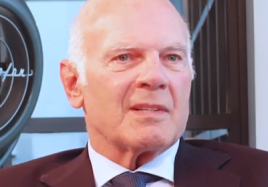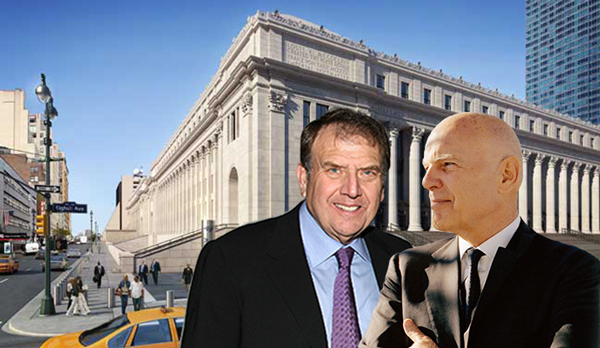How much power does the national infrastructure council assembled by Donald Trump really have? Richard LeFrak, one of its members, stayed silent for a few seconds and then sighed deeply, to the laughter of the audience. “That’s a good question,” he said. “Some of us do have the president’s ear from time to time, and so if that means the commission will have some authority, that’s the authority.”
LeFrak’s [TRDataCustom] comment set the expectations at the International Finance & Infrastructure Forum hosted by Bloomberg and the China General Chamber of Commerce Monday: No one is in any position to predict what infrastructure spending plan will emerge from the White House, if one emerges at all. But the assembled investors seemed to sense there are new opportunities for profit.
Jim Reynolds, who co-founded the JLC Infrastructure Fund with basketball star-turned real estate investor Magic Johnson (also on the panel), argued for an all-out privatization of some public infrastructure assets. “Why is it that the governments need to own all these things?” he asked, arguing that Heathrow is a better airport than LaGuardia because of private investors. (The more complicated issue of whether privatizing airports and rest stops creates harmful monopolies was left unaddressed.)
LeFrak didn’t go quite as far as calling for private ownership of infrastructure, but he did argue that the U.S. needs to figure out ways to pay for it. “The regulatory process is broken, but the revenue process is also broken,” he said. In order to pay for roads and bridges, the government has a choice between two unpopular options: raising taxes or usage fees. “Political courage is needed right now,” he said, adding that states and cities have shown more willingness to raise funds for infrastructure than Washington.
Trump hinted at a $1 trillion infrastructure spending plan in October, prior to his election victory, and in January created the council to monitor national spending on projects.
The big, unanswered question was whether foreign (and especially Chinese) money could help pay for U.S. infrastructure construction. “The idea of having foreign investors is a powerful tool in the toolbox,” Kentucky governor Matt Bevin, a Republican, said.
At an earlier panel, another member of Trump’s council, Vornado Realty Trust’s Steve Roth, offered some very broad outlines of a potential White House infrastructure plan.
Though short on details, Roth said the $1 trillion plan’s capital structure would be “fairly well leveraged.”
“There is a place for government capital, which is in the risk position, and then there is private capital that can be brought to bear and then there’s an enormous amount of leverage and debt that can be brought to bear,” Roth said.
For a $1 trillion program, the equity portion could be $200 billion or less, according to Roth. “The $1 trillion number is significant; the actual [equity] investment will be a fraction of that based upon the multiplier effect,” he said.
In addition to Roth, panelists included John Schmidt, an attorney at Mayer Brown specializing in infrastructure; Rick Cotton, special counsel on interagency initiatives for Gov. Andrew Cuomo; and Ning Yuan, president of China Construction America Inc.
“The U.S. has just gone through an unbelievably contentious, difficult, long, hard-fought election, where the divisions in the country and electorate were expansive and raw,” Roth said. “The one thing that was universally agreed to was that American’s infrastructure was subpar.”
To date, the Vornado chief said U.S. infrastructure projects have been “mired down” by an array of impediments, from decentralized government oversight, strained local budgets and four-year political cycles that can derail and delay projects. The “cumbersome” approval process can and should be streamlined for efficiency, he said. “That’s something that I think is doable, should be doable and will be doable,” he said.

Further reading on Vornado Realty Trust
including stories and deals
Roth chalked up America’s “subpar” infrastructure to being early out of the gate during the last century, when major roadways, tunnels and bridges were built. “We started 100 years ago. We’re now competing with countries on the rise that are building new airports — 3, 4, 5 a year,” he said. “We were early and now we’ve got a little bit of catch up.”
Private capital isn’t “public benefit money,” cautioned Cotton. “There has to be a revenue stream someplace. The private capital is there to make a profit,” he said.
But private money seems tremendous upside for infrastructure. Ning Yuan of China Construction said his company’s been sitting on the sidelines for more infrastructure projects to be approved. The company approved $1 billion worth of equity investment in public-private partnership projects, which could generate $10 billion worth of work.
Sovereign wealth and pension funds are also eager to invest in the U.S., said Schmitt.
“They’re doing it around the world, they want to be in the U.S.,” he said. “The equity isn’t necessarily that $1 trillion, but the $200 billion of equity that can support the $1 trillion would be easy to find.”
Roth concurred that investors are lining up to deploy capital in “the highest quality asset in arguably the best country,” he said. “What could be better collateral than LaGuardia airport?” he quipped.
